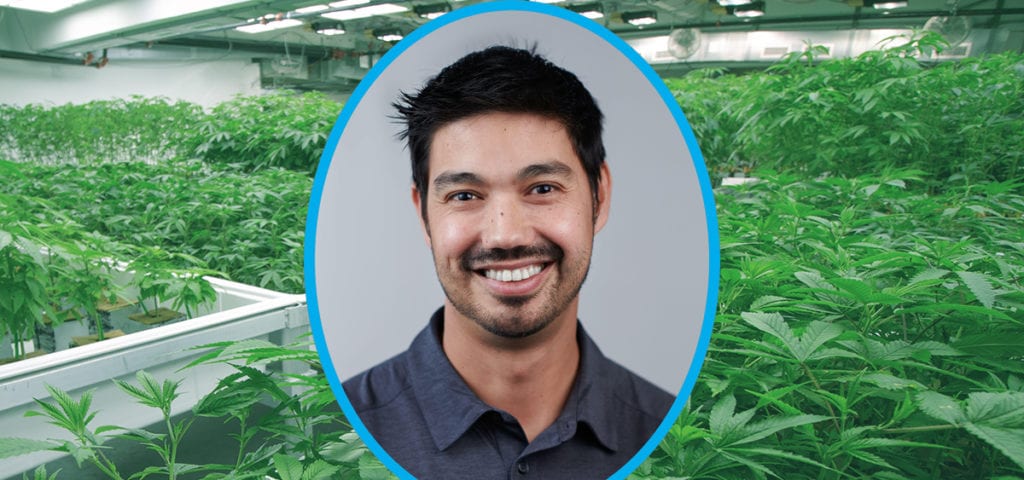Robert Soler is the Vice President of Biological Research and Technology at BIOS, a lighting solutions company that offers LEDs specialized for plant growth.
Robert Soler: Creating Biologically-Tuned LED Grow Lights

Full story continued below.
Advertisement
Before his work at BIOS, Robert Soler acquired a Master of Science degree from the Lighting Research Center at Rensselaer Polytechnic Institute and a PhD in Behavioral Neuroscience from the University of California, San Diego. Robert also helped design and build the lighting system on the International Space Station (ISS) — he collaborated with scientists to use LED lighting for photobiological purposes in space, which included designing a circadian lighting system to synchronize circadian rhythms of astronauts aboard the ISS. Through this experience, he gained insight into how LEDs could be utilized to develop valuable technology for the cannabis industry.
This interview covers how BIOS uses biology to understand and create optimized lighting systems, the benefits of growing cannabis under LEDs, and more!
Ganjapreneur: What is the origin story behind BIOS, and what led to the decision to create energy-efficient grow lights for indoor cultivation?
Robert Soler: I’d say BIOS started at NASA’s Space Life Sciences Lab, where I was an engineer designing lighting technologies for all types of life. There I learned about how LED lighting could be used to change plant morphology, provide unique seasonal cues and drive the most efficient photosynthetic growth.
On the BIOS website it states that your products are “designed by nature.” How does BIOS use plant biology to direct product development?
Rather than taking a technology and trying to shoehorn it into a biological application, BIOS is looking at the biological mechanisms, photobiology and biochemistry and develops technology based on that fundamental science.
What are some of the benefits of cultivating cannabis indoors with LED lighting?
The main benefit is consistency. Indoor lighting as a whole is more consistent day-to-day. When comparing to HPS indoors, LED provides the most uniformity. This bodes well for the crop, ensuring no portions of the plant is getting too much light and no portions are getting too little. This will lead to more consistent yields and higher yields harvest after harvest.
Research suggests that LED lighting can increase biosynthesis of flavonoids in fruits and some plant species. Could these results translate to the elaborate system of secondary compounds found in cannabis flowers?
Absolutely! Spectrum is the key to these secondary compounds. A couple of tweaks to say the near UV can help boost some things while far reds can boost others. We haven’t testing everything yet, but we can help you get there with some basics.
How does BIOS lighting differ from other LED lighting options on the market?
BIOS is dedicated to the grower. We think about things from the perspective of the plant, and operators when we design our products. An example of this is our optimized white light spectrum, providing the optimal photosynthetic yield without compromising the comfort of the workers inside the facility. Another example is our industrial grade fixtures, designed to take all the dirt and water you can throw at it, and wipe clean to keep you producing. A final example that we’re really proud of is our upcoming rapid rack system designed to get these lights up in record time.
What scale of indoor cultivation project is a good fit for a BIOS system?
I haven’t seen a bad scale of a project. Small ones are good for R&D. Tweaking spectrums and learning about your product.
What are the most common mistakes that cannabis cultivators make when switching over to LED lights after using other indoor cultivation lighting systems?
The most common one is temperature. The leaf temperature is much cooler when grown under LED lights compared to Sodium (HPS) lamps. This means you need to run your HVAC a few degrees warmer to obtain the best benefits. The other major one is measuring light. Light intensity is so important to the plant growth, yet few people measure it correctly. You measure in umol/m2, not lux, at the canopy level.
How does BIOS continue to support cultivators who are using your products?
BIOS is committed to helping our customers throughout the life of our products. We provide our customers with tips on maintenance and troubleshooting (even if it has nothing to do with the lights). We also work hand in hand with those growers who are looking at tweaking spectrum and once that spectrum is finalized, we help them cost effectively scale that unique spectrum to a full scale grow facility.
Thank you, Robert, for answering our questions! You can learn more about Robert Soler and BIOS’s offerings at BIOSlighting.com.
Get daily news insights in your inbox. Subscribe
End